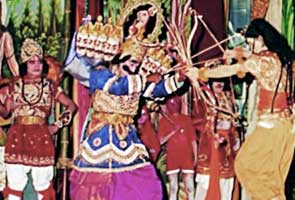And that unwarranted violence erupted again, the two seemingly divergent communities headed for another clash. For that matter these two entities have for a long time since post-independence been wary of each other on numerous fronts. In midst of the Durga Puja celebrations it was Faizabad that was witnessing friction between the Hindus and Muslims yet again over what else the security of their religious interests.
Allegedly while the procession being taken out by the Hindus was hampered, the shops owned by the Muslims were targeted and were gutted accompanied by looting in a planned manner, at least this is what the fact finding team of human rights organization, Rihai Manch has come to conclude. Interestingly before the news started pouring in on news portals and caught up with the scribes, my eyes were in fact glued to the Special series of CNN-IBN on the tradition of Ramlila. Isn't it an irony that the city of Faizabad that boasts of hosting the longest Ramlila (well, it has been going on for the past two years) failed to aid the residents of killing their own demons before the symbolic one.
This sense of distrust and that perpetual vacuum is not an offshoot of recent past it has in fact become ingrained in our social system thanks to the efforts of the erstwhile rulers the British and their chicanery which ceased to fizzle ever since. 'Divide and Rule' a political ideology that ensured the hegemony of the British, a fact so well corroborated in Maria Mishra's 'Vishnu's Crowded Temple'. In the 1880s in the backdrop of the National Movement gaining ground with the Congress playing a lead role, Muslims led by Aga Khan had begun to espouse the cause of what they believed to be moderate nationalism. In the year 1893 Bal Gangadhar Tilak a fiery nationalist brought into the public domain the idea of the celebration of the Ganpati Festival. The intention behind the enunciation of a new chain of festivity was to divert the Hindus from participating in Moharram processions which at that time had dancers and singers from the Hindu community adding on to the occasion. Thus progressivism eventually evolved into a pejorative in an attempt to consolidate a larger section that was oblivious of the institutional thought being imposed on them. And such designs worked for the British too when the MacDonald led National Government (1931-32) gave a nod to the provincial autonomy to the Muslims. This led to the coming into existence the 'Communal Award', electoral majorities carved out in Bengal and Punjab.
Unfortunately the seeds sown way back continue to bear vicious fruits till date. Why this might not cause any ruffle among the broadcast community busy trailing the movements of an anti-corruption crusader these days, one needs to sit down and ponder how can such incongruities be taken care of now an din years to come. Yes, communal clash is a crude reality of Indian society which victimizes a particular class and its consequences are borne by another and yet it fades into the normal din as if its an acceptable trend in this country. Vetting the recent clashes shall reveal that somewhere exists a crevice which is utilized by the bellicose yet pseudo-nationalist to assert their antediluvian beliefs. And yet if you ever happen to visit the Sadar Bazaar and get to watch the Ram Barat taken out every year during the Navratri, the conveners shall lead you to believe that this procession that makes way through Muslim dominated area is intended to promote harmony among the two communities. If only the political puppets and staunch saffronites could lend an ear to what these people have got to say in the video below and if these words could have a reckoning beyond the limits of Baratooti Chowk, Old Delhi.


No comments:
Post a Comment